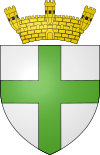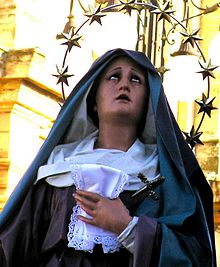Żejtun
| coat of arms | map |
|---|---|

|
|
| Basic data | |
| State : | Malta |
| Gzejjer : | Malta Xlokk (Southeast Malta) |
| Distretti : | South Eastern |
| Area : | 5,367.37 km² |
| Residents : | 11,386 (December 31, 2018) |
| Population density : | 2121 inhabitants / km² |
| ISO 3166-2 : | MT-67 |
| Postal code : | ŻTN |
| Website : | http://www.zejtunlocalcouncil.com/ |
| politics | |
| Mayor : | Joseph Attard ( MLP ) |
Coordinates: 35 ° 51 ' N , 14 ° 32' E
Żejtun [ zɛɪ̯ˈtʊːn ] (also: Iż-Żejtun ) is a city in the east of Malta with a population of 11,386 (as of December 31, 2018). Żejtun also has the title Città Beland , which was given to her by Ferdinand von Hompesch zu Bolheim , Grand Master of the Order of Malta in 1797. "Zaytūn" (زيتون) is the Arabic word for olive and refers to the production of olive oil , one of the main industries in Malta. The current pastor is Nicholas Pace and the current mayor is Joe Attard.
history
In the Middle Ages , the area around Żejtun - the south of Malta - was known as le terre di Santa Caterina (Land of St. Catherine). Italian was the official language at the time. Various new settlements emerged from the parish of Żejtun, such as G Ausaxaq and Marsaxlokk . Each of these settlements is now its own parish. The militia regiment stationed in Żejtun was the first to take on the Turks at the start of the great siege in 1565, but until 1614 the city suffered from raids by Turkish pirates . That year, the forces stationed in Żejtun repelled a Turkish attack without the help of other units. During the French naval blockade from 1799 to 1801, the city played a rather subordinate role as a barracks. As one of the first cities outside the fortifications around the Great Harbor, Żejtun had a public park, the Luqa Briffa Garden , which was named after a well-known cavalryman from the time of the Great Siege of Malta.
Żejtun survived the British occupation of the Maltese islands as a rural retreat in the green fields of the Mazza Valley . It owned just one of the many hospitals where British and French soldiers were cared for during World War I , which earned the islands the nickname “Nurse of the Mediterranean”. With the Maltese independence, the city was expanded to include the historic city center with private homes, commercial areas and other residential developments .
For the past fifty years, the city has been known for its heated political struggles, culminating in a real battle between supporters of the nationalists (Partid Nazzjonalista) and those of the Labor Party (Malta Labor Party) in the Tal-Barrani street in 1987 . The city is linked to Malta's dark political history in the 1980s, and its residents are still not well respected due to the heated political debates in Malta.
Churches, chapels and historical remains
The city has a number of Roman legacies, e.g. B. a Roman villa and a church dedicated to Saint Catherine of Alexandria . Its foundation stone was consecrated in 1622 and the first parish priest was Dun Pawl Branchel. This church, completed in 1720, was the successor to an earlier church that is still on the outskirts today and is also dedicated to St. Catherine, but is known to the population as St. Gregory. Presumably this is due to the annual procession for this saint, which moved here from Mdina in the Middle Ages .
Żejtun has a large number of chapels. B. St. Clement, Our Lady of Good Counsel, the Most Holy Redeemer, the Assumption of Mary into Heaven, the Holy Spirit and St. Angelus are dedicated.
The town festival

The most important event of the year is the feast of Saint Catherine of Alexandria , which is celebrated in the summer and not on the actual day of remembrance, November 25th. On this day, the two rival music trains from Żejtun, the “Banda Beland” and the “Żejtun Band” play in Gregory Bonnici Square (the city's main square). The hymn of Saint Catherine, sung during the festival in Żejtun, was written by Emmanuele Palmier-Cecy and composed by Dun Lawrence Mifsud. Until the 1970s , the second festival was that of “Our Lady of Doctrine” (Maria).
schools
Another famous composer who was born in Żejtun was Carlo Diacono . A girl's junior lyceum, a few streets away from St. Gregory's Church, was named after him. Another school in Żejtun worth mentioning is the elementary school, the building of which was built in neo-classical style during the British occupation.
Web links
Individual evidence
- ↑ StatDB of the National Statistics Office Malta , accessed on August 1, 2020



